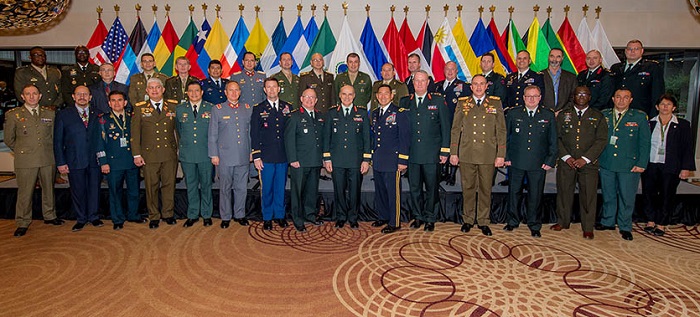By Natalie Flynn
From February 6 to 10, 2017, the Canadian Army is hosting a special multi-lateral conference in Toronto. The event is part of the 32nd cycle of the Conference of American Armies (CAA), an international gathering of associated militaries consisting of six major meetings held over a period of two years. Founded in 1960, the CAA is designed to strengthen relationships on an army-to-army basis, to promote cohesion and to help improve security in the Americas.
The CAA is an International Military Organization founded in 1960 and provides an opportunity for Army leaders from North, Central and South America and the Caribbean to meet on a regular basis to discuss areas of mutual interest and share lessons learned. In this way, the CAA contributes, from a military thinkers’ point of view to the security and democratic development of member countries. Canada joined the CAA in 1993, and the Canadian Army has hosted six events since becoming a member.
The twenty armies of the CAA today are Antigua & Barbuda, Argentina, Bolivia, Brazil, Canada, Chile, Colombia, Dominican Republic, Ecuador, El Salvador, Guatemala, Honduras, Mexico, Nicaragua, Paraguay, Peru, Trinidad & Tobago, United States, Uruguay, and Venezuela.
The five observer armies of the CAA are Barbados, Belize, Guyana, Jamaica, and Suriname, while the Special Observer Army is Spain. Two international military organizations also enjoy observer status: the Central American Armed Forces Conference and the Inter-American Defense Board.
During these conferences, army officers have a unique opportunity to meet and discuss issues of mutual interest, including best practices for peacekeeping operations, disaster response, and emerging security challenges. A commanders’ conference rounds out the end of the cycle, where leadership can vote on the decisions and outcomes from the previous two years.
The 32nd cycle marks the sixth time that the Canadian Army has hosted a conference since joining the CAA in 1993. The overarching theme for the six events in this cycle examined how armies can work with different levels of organizations in the face of growing challenges to regional defence while considering the different capabilities, roles and legal frameworks of each country.
One of the Canadian Army’s core roles is to contribute to international peace and security, and being a member of the CAA is a strong contributor in delivering on these obligations. “It is through this long-term and active multilateral dialogue that we can better understand and identify the needs, challenges, and areas for potential collaboration in pursuit of common goals,” said Lieutenant-General Paul Wynnyk, Commander of the Canadian Army. “Canada is a committed partner in these efforts and will continue to work with member nations to address complex security challenges in a manner that promotes partnerships and cooperation.”
In line with the theme, the Canadian Army’s designated topic for the CAA‘s Specialized Conference focused on the training aspect of interagency operations, which includes large-scale planned activities, such as major athletic events and summits, and unexpected incidents, such as natural disasters. Presentations by the Canadian Army covered planning and preparation, lessons learned and environmental concerns when on location during operations.
According to LGen Wynnyk, this is an area for which the Canadian Army is well-positioned to provide expertise, given its experiences with major domestic security operations and responses to natural disasters, both domestic and international. Case studies discussed during the Specialized Conference included security for the Vancouver Olympic Games and the G20 summit in Toronto, as well as preparing for a major earthquake on the west coast of Canada.
Secretary General of the CAA 32nd Cycle, Major General Clarence K.K. Chinn, Commander U.S. Army South, welcomed the opportunity to discuss operations in the interagency environment, saying, “The reality of the current global state of affairs is increased instability, which now more than ever underpins the importance for our armies to continue to dialogue and work together to protect our interests.”
Major General Chinn went on to add, “Although all armies do not have the same resources, and differ in our policies and programs, through cooperation we can identify the gaps and friction points, and take action to benefit all partners mutually. As an organization, we have come a long way to synchronizing our efforts and this specialized conference is an outstanding opportunity to delve into some particulars, specifically on training our forces, on how we presently do business and where we can improve.”
LGen Wynnyk emphasized that the Canadian military plays an important role in working collaboratively with partners throughout the hemisphere to develop regional capabilities, encourage operational flexibility and foster military professionalization. Bilateral cooperation continues to grow with priority partners Mexico, Brazil, Chile, Colombia, and Jamaica. Engagement has also increased significantly in other parts of the Caribbean as well as in Central America.
LGen Wynnyk is optimistic about the future, saying that continued participation in the CAA “presents Canada with a tremendous opportunity to demonstrate continued leadership and to facilitate regional capacity building.”
Natalie Flynn is a member of the Army Public Affairs

